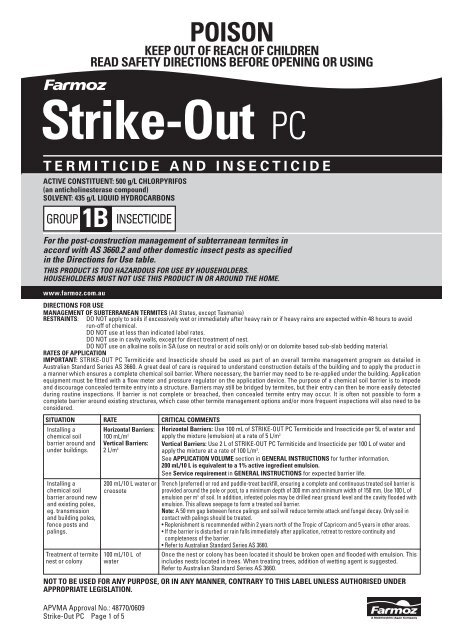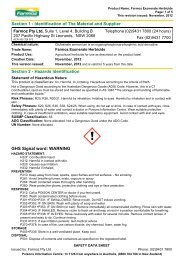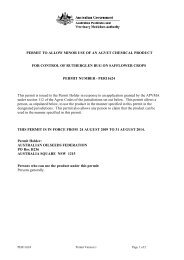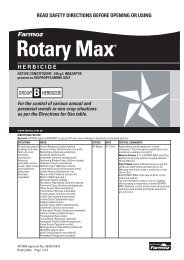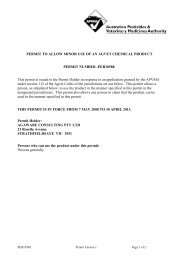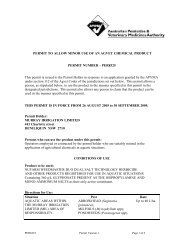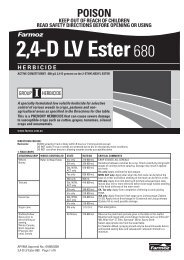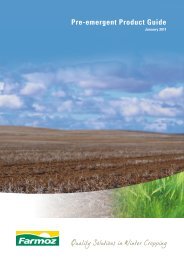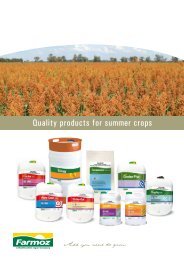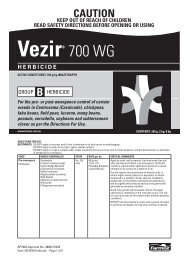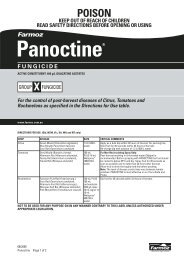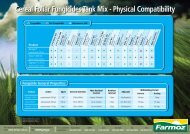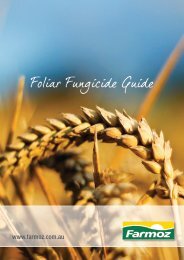Strike-Out PC pmanual - Farmoz
Strike-Out PC pmanual - Farmoz
Strike-Out PC pmanual - Farmoz
You also want an ePaper? Increase the reach of your titles
YUMPU automatically turns print PDFs into web optimized ePapers that Google loves.
For the post-construction management of subterranean termites in<br />
accord with AS 3660.2 and other domestic insect pests as specified<br />
in the Directions for Use table.<br />
THIS PRODUCT IS TOO HAZARDOUS FOR USE BY HOUSEHOLDERS.<br />
HOUSEHOLDERS MUST NOT USE THIS PRODUCT IN OR AROUND THE HOME.<br />
www.farmoz.com.au<br />
DIRECTIONS FOR USE<br />
MANAGEMENT OF SUBTERRANEAN TERMITES (All States, except Tasmania)<br />
RESTRAINTS: DO NOT apply to soils if excessively wet or immediately after heavy rain or if heavy rains are expected within 48 hours to avoid<br />
run-off of chemical.<br />
DO NOT use at less than indicated label rates.<br />
DO NOT use in cavity walls, except for direct treatment of nest.<br />
DO NOT use on alkaline soils in SA (use on neutral or acid soils only) or on dolomite based sub-slab bedding material.<br />
RATES OF APPLICATION<br />
IMPORTANT: STRIKE-OUT <strong>PC</strong> Termiticide and Insecticide should be used as part of an overall termite management program as detailed in<br />
Australian Standard Series AS 3660. A great deal of care is required to understand construction details of the building and to apply the product in<br />
a manner which ensures a complete chemical soil barrier. Where necessary, the barrier may need to be re-applied under the building. Application<br />
equipment must be fitted with a flow meter and pressure regulator on the application device. The purpose of a chemical soil barrier is to impede<br />
and discourage concealed termite entry into a structure. Barriers may still be bridged by termites, but their entry can then be more easily detected<br />
during routine inspections. If barrier is not complete or breached, then concealed termite entry may occur. It is often not possible to form a<br />
complete barrier around existing structures, which case other termite management options and/or more frequent inspections will also need to be<br />
considered.<br />
SITUATION RATE CRITICAL COMMENTS<br />
Installing a<br />
chemical soil<br />
barrier around and<br />
under buildings.<br />
Installing a<br />
chemical soil<br />
barrier around new<br />
and existing poles,<br />
eg. transmission<br />
and building poles,<br />
fence posts and<br />
palings.<br />
Treatment of termite<br />
nest or colony<br />
POISON<br />
KEEP OUT OF REACH OF CHILDREN<br />
READ SAFETY DIRECTIONS BEFORE OPENING OR USING<br />
<strong>Strike</strong>-<strong>Out</strong> <strong>PC</strong><br />
TERMITICIDE AND INSECTICIDE<br />
ACTIVE CONSTITUENT: 500 g/L CHLORPYRIFOS<br />
(an anticholinesterase compound)<br />
SOLVENT: 435 g/L LIQUID HYDROCARBONS<br />
1B<br />
GROUP INSECTICIDE<br />
Horizontal Barriers:<br />
100 mL/m 2<br />
Vertical Barriers:<br />
2 L/m 3<br />
200 mL/10 L water or<br />
creosote<br />
100 mL/10 L of<br />
water<br />
APVMA Approval No.: 48770/0609<br />
<strong>Strike</strong>-<strong>Out</strong> <strong>PC</strong> Page 1 of 5<br />
Horizontal Barriers: Use 100 mL of STRIKE-OUT <strong>PC</strong> Termiticide and Insecticide per 5L of water and<br />
apply the mixture (emulsion) at a rate of 5 L/m2. Vertical Barriers: Use 2 L of STRIKE-OUT <strong>PC</strong> Termiticide and Insecticide per 100 L of water and<br />
apply the mixture at a rate of 100 L/m3 .<br />
See APPLICATION VOLUME section in GENERAL INSTRUCTIONS for further information.<br />
200 mL/10 L is equivalent to a 1% active ingredient emulsion.<br />
See Service requirement in GENERAL INSTRUCTIONS for expected barrier life.<br />
Trench (preferred) or rod and puddle-treat backfill, ensuring a complete and continuous treated soil barrier is<br />
provided around the pole or post, to a minimum depth of 300 mm and minimum width of 150 mm. Use 100 L of<br />
emulsion per m3 of soil. In addition, infested poles may be drilled near ground level and the cavity flooded with<br />
emulsion. This allows seepage to form a treated soil barrier.<br />
Note: A 50 mm gap between fence palings and soil will reduce termite attack and fungal decay. Only soil in<br />
contact with palings should be treated.<br />
• Replenishment is recommended within 2 years north of the Tropic of Capricorn and 5 years in other areas.<br />
• If the barrier is disturbed or rain falls immediately after application, retreat to restore continuity and<br />
completeness of the barrier.<br />
• Refer to Australian Standard Series AS 3660.<br />
Once the nest or colony has been located it should be broken open and flooded with emulsion. This<br />
includes nests located in trees. When treating trees, addition of wetting agent is suggested.<br />
Refer to Australian Standard Series AS 3660.<br />
NOT TO BE USED FOR ANY PURPOSE, OR IN ANY MANNER, CONTRARY TO THIS LABEL UNLESS AUTHORISED UNDER<br />
APPROPRIATE LEGISLATION.
GENERAL INSTRUCTIONS: TERMITE MANAGEMENT<br />
To minimise the risk of termite infestation, the subfloor area of<br />
buildings should be kept free of stored or waste timber and all other<br />
building materials that attract termites. Appropriate action should also<br />
be taken to eliminate any undue dampness caused by leaking water or<br />
sewerage pipes, or inadequate drainage. Subterranean termites need<br />
a constant source of moisture to survive. Provision of adequate<br />
ventilation in the sub-floor area also helps eliminate undue dampness.<br />
Pest managers using this product for termite management should<br />
advise the home owner that disturbing the treated soil barrier with<br />
subsequent construction of additions or alterations, paths, steps,<br />
landscaping etc, may render the termite management system in place<br />
ineffective unless further management options are considered.<br />
Colonies not in contact with the ground<br />
Occasionally subterranean termites establish a colony in a building<br />
without having contact with the soil because they have access to a<br />
continuous supply of moisture (e.g. from a faulty plumbing fixture or<br />
leaking roof). Such colonies are not affected by chemical soil barriers<br />
and should be treated as recommended for established colonies, as<br />
per Australian Standard Series AS 3660. STRIKE-OUT <strong>PC</strong> Termiticide<br />
and Insecticide may be applied directly to the termite colony in such<br />
situations.<br />
Service Requirement<br />
Regular, competent inspections by a licensed Pest Manager are<br />
recommended as part of an overall termite management program to<br />
determine the prevailing termite pressure and environmental<br />
conditions and consequent requirement for further termite<br />
management options. Inspections should be performed at least on an<br />
annual basis, but more frequent inspections are strongly<br />
recommended. At the 1% application rate, STRIKE-OUT <strong>PC</strong> Termiticide<br />
and Insecticide can provide an effective chemical soil barrier in<br />
subfloor regions for 4 years or more north of the Tropic of Capricorn,<br />
and 10 years or more south of the Tropic of Capricorn. At the 1%<br />
application rate, STRIKE-OUT <strong>PC</strong> Termiticide and Insecticide can<br />
provide an effective chemical soil barrier in exposed situations for 2<br />
years or more north of the Tropic of Capricorn, and up to 5 years or<br />
more south of the Tropic of Capricorn. The actual period of efficacy<br />
will depend on many factors such as termite hazard, climatic<br />
conditions, soil types and soil disturbance and gardening/landscaping<br />
practices.<br />
APPLICATION INSTRUCTIONS:<br />
1. Application Equipment<br />
Hand Spraying: For hand spraying use a rose head shrouded nozzle<br />
operated at 170 kPa and with a flow meter and pressure regulator<br />
fitted to the hand-piece.<br />
Injection Through Concrete Slabs or Sealed Areas<br />
Use a sub-slab injector fitted with a multi-directional tip (a B&G, or<br />
similar system) with a 5 degree upward angle (e.g. 3 way or 4 way) and<br />
operated at 170 kPa. Ensure a strong seal with the top of the drill hole<br />
to avoid leakage. For the best distribution, the injector needs to be held<br />
vertically at right angles to the slab and rotated during the application<br />
through 90 degrees if using a 4 way dispersion tip, or through 180<br />
degrees for a 3 way dispersion tip.<br />
Injection into Soil<br />
Use a soil rod with a 3 or 4 way multi-directional tip (B&G, or similar)<br />
operated at 170 kPa. The 4 way tip needs to be rotated during the<br />
application through 90 degrees and the 3 way tip through 180 degrees.<br />
2. Application Volume<br />
To compensate for impervious soils such as clays where application of<br />
5 L/m2 would cause run-off it may be necessary to apply a volume of<br />
emulsion less than 5 L/m2 . When reducing the volume of emulsion<br />
used, increase the concentration accordingly to match the label rate<br />
by mixing the required amount of STRIKE-OUT <strong>PC</strong> per m2 in a lesser<br />
volume of water. DO NOT use emulsion volumes less than 2 L/m2 .<br />
NOTE: Use of emulsion volumes other than the recommended 5 L/m2 is<br />
only permitted when installing barriers in exposed soil. It is not<br />
permitted when injecting through the slab or into sealed areas.<br />
Existing Structures:<br />
a) Strategic Drilling Through Slab, or Sealed Areas<br />
For treatment of slabs when termites are entering the building through<br />
the slab and where reticulation systems do not exist, slab drilling and<br />
injection will be required. In most cases, unless there is a known<br />
severe termite hazard, grid drilling of the slab is not required. Any such<br />
need is to be determined by a licensed Pest Control Operator.<br />
Treatment needs to be made around the inside of all exterior walls to<br />
complete a termite barrier, along both sides of interior wall partitions,<br />
around plumbing/electrical or piping entry points and along one side of<br />
major cracks or expansion joints. For a sand base or sandy soil, apply<br />
through a row of holes drilled 300 mm apart and 100-200 mm out from<br />
the wall, crack or pipe. For a clay base, apply through a row of holes<br />
drilled 150 mm apart and 100 mm from the wall, crack or pipe. Apply 10<br />
<strong>Strike</strong>-<strong>Out</strong> <strong>PC</strong> Page 2 of 5<br />
L of emulsion per linear metre and ensure the holes are securely<br />
plugged after treatment.<br />
b) External Barriers<br />
An external barrier should be installed around the perimeter of the<br />
building and should circumference all pipes and service facilities.<br />
External barriers should be created by using either a vertical or<br />
horizontal barrier, as determined by the building construction type and<br />
adjoining ground level. An external barrier is an essential part of the<br />
treatment when relying on a chemical soil barrier to provide the full<br />
termite management system as per AS 3660.<br />
An external horizontal barrier is only required when prevention of<br />
concealed vertical access by termites is necessary at the perimeter<br />
(eg, when ground level is equal to the top of a slab, where the slab is<br />
also a barrier to concealed termite movement into the building). A<br />
vertical barrier is required when prevention of concealed horizontal<br />
access is necessary (eg, where ground level is higher than building<br />
material vulnerable to concealed horizontal entry by termites).<br />
i) Horizontal Barrier: Use a rose head shower nozzle operated at 170<br />
kPa to apply the required rate of 1.5 L of the correctly diluted<br />
STRIKE-OUT <strong>PC</strong> Termiticide and Insecticide per lineal meter (150<br />
mm wide) to soil loosened to a depth of approximately 80mm (see<br />
APPLICATION VOLUME Section)<br />
ii) Vertical Barrier: The vertical barrier should be at least 150 mm<br />
wide and should reach down to 50 mm below the top of the<br />
footings. To achieve this trench to the top of the footings, and<br />
where this is not possible, a combination of trenching (preferably<br />
at least 300 mm deep) and rodding into the base of the trench may<br />
be necessary.<br />
Apply STRIKE-OUT <strong>PC</strong> Termiticide and Insecticide emulsion at 100 L<br />
per cubic metre of backfill soil, this equates to 1.5 L of emulsion/linear<br />
metre of a trench 150 mm wide and 100 mm deep. Where the required<br />
vertical barrier is deeper than 100 mm, ensure the same rate of<br />
application for the extra volume of soil. Use a rose head shower nozzle<br />
operated at 170 kPa to flood the base of the open trench and also to<br />
treat the backfill soil as it is replaced into the trench to ensure even<br />
distribution. Where rodding is necessary, rod before the trench is<br />
treated using the spacings in the following table.<br />
Rod Spacings<br />
Heavy Clay Clay Loams Sands<br />
150 mm 200 mm 300 mm<br />
Insert the rod to the foundation foot as close as possible to the house<br />
wall ensuring the chemical is applied during insertion and withdrawal.<br />
(See APPLICATION EQUIPMENT SECTION, Injection into Soil).<br />
c) Suspended Floors<br />
Install horizontal and vertical barriers as specified in Australian<br />
Standard Series 3660 to abut all substructure walls, stumps, piers,<br />
pipes and wastes using the appropriate techniques described for<br />
external barriers around concrete slabs (See Existing Structures<br />
Section).<br />
3. Retreatment/Service Requirement<br />
Regular competent inspection is required to determine the need for retreatment.<br />
Annual inspection by a licensed Pest Control Operator is<br />
recommended.<br />
The expected life of the under floor barrier is at least 4 years north of<br />
the Tropic of Capricorn, and at least 10 years south of the Tropic of<br />
Capricorn.<br />
The expected life of the external barrier is at least 2 years north of the<br />
Tropic of Capricorn, and at least 5 years south of the Tropic of<br />
Capricorn. The actual period of protection will depend on factors such<br />
as termite hazard, climate, soil conditions and soil disturbance.<br />
CLEANING SPRAY EQUIPMENT<br />
• Rinse water should be discharged onto approved disposal areas in<br />
accordance with appropriate State legislation or if this is unavailable,<br />
onto unused land away from buildings, desirable plants and water<br />
courses. DO NOT put rinse water down sewers, gutters or storm<br />
water drains.<br />
• After using STRIKE-OUT <strong>PC</strong> Termiticide and Insecticide, empty the<br />
spray equipment completely and drain the whole system. Thoroughly<br />
wash inside the tank using a pressure hose, and drain. To wash the<br />
system, quarter fill the tank with clean water and circulate through<br />
the pump, lines, hoses and nozzles. Drain and repeat the washing<br />
procedure twice.
RATES OF APPLICATION: GENERAL PEST CONTROL.<br />
SITUATION PEST STATE RATE CRITICAL COMMENTS<br />
Domestic and<br />
public places,<br />
commercial and<br />
industrial areas<br />
Cockroaches<br />
(residual control<br />
and/or heavy<br />
infestations),<br />
Spiders, Silverfish<br />
<strong>Strike</strong>-<strong>Out</strong> <strong>PC</strong> Page 3 of 5<br />
All States 95 mL/10 L<br />
water<br />
Cockroaches<br />
(light infestations)<br />
Ants<br />
Argentine ants NSW, Vic, Tas,<br />
SA, WA only<br />
Fleas (outdoor use<br />
only)<br />
Qld, NSW, Tas,<br />
SA, WA, NT<br />
only<br />
50 mL/10 L<br />
water<br />
95 mL/<br />
10 L water.<br />
Use at<br />
least 1 L of<br />
spray/10 m 2<br />
90 mL/10 L<br />
of water<br />
Apply as a coarse, low pressure spray to the point of run-off, to cracks,<br />
crevices, harbourages and other places where pests may occur. Note: A<br />
period of 4 to 7 days is normally required for maximum effect on cockroaches.<br />
Add 25 g/L of suitable pyrethroid or dichlorvos (DDVP) insecticide to the<br />
spray mixture where a rapid knockdown and flushing is desired.<br />
Spray ant tracks, nests or where ant activity is noticed. Apply to paths in<br />
continuous 30 cm bands. Apply to base of buildings, walls, fences, rockworks,<br />
trunks of shrubs and trees and other hard surfaces to a height of 30 cm.<br />
Note: Argentine ants in WA: for domestic use only. All occurrences of<br />
Argentine ants are to be reported to the WA Department of Agriculture.<br />
Hides/skins Hide beetles All States 200 mL/ Apply spray to flesh side of skins or hides sufficient to moisten them.<br />
100 L water. Insure coverage of ears and lugs. To minimise the chance of later<br />
Use at least infestation, storage areas should be sprayed regularly. Repeat<br />
30 mL of application every 3 months. Access through bales should be maintained<br />
spray/<br />
sheep skin<br />
for application of insecticide.<br />
Light vegetation Mosquito larvae Qld, NSW, Vic, 30 mL/ha Apply diluted in water as a spray to areas infested with mosquitoes.<br />
Medium vegetation<br />
Heavy vegetation<br />
SA, WA, NT<br />
only<br />
60 mL/ha<br />
105 mL/ha<br />
Light to medium<br />
vegetation<br />
Mosquito adults All States 60 mL/ha<br />
Medium to heavy<br />
vegetation<br />
105 mL/ha<br />
Polluted water<br />
2 mL/<br />
impoundments<br />
10000 L<br />
of water<br />
or 20 mL/<br />
100 m3 Mosquitoes<br />
(larvae and adults)<br />
ORNAMENTALS AND TURF<br />
CROP PEST STATE RATE CRITICAL COMMENTS<br />
Potted Ornamentals Scarab Beetles -<br />
Larvae<br />
Qld only 20 to<br />
40 mL/<br />
100 L water<br />
Turf Funnel Ant Qld, NSW only 2.0 L/ha or<br />
5 mL/5 L<br />
spot spray<br />
African Black<br />
Beetle<br />
Argentine Stem<br />
Weevil<br />
Blackheaded<br />
Pasture Cockchafer<br />
Brown Pasture<br />
Looper<br />
Pasture Webworm<br />
Qld, NSW, Vic,<br />
WA only<br />
NSW, Vic, Tas,<br />
SA, WA only<br />
6.0 L/ha<br />
or 60 mL/<br />
100 m 2<br />
4.0 L/ha<br />
or 40 mL/<br />
100 m 2<br />
900 mL/ha<br />
or 9 mL/<br />
100 m2 700 mL/ha<br />
or 7 mL/<br />
100 m2 Apply as a fine-particle spray.<br />
<strong>Out</strong>doors: Use higher rate to treat areas where animals rest and/or where<br />
pests have been seen.<br />
DO NOT treat pets infested with fleas with this product. Pets should be<br />
treated with a product registered for application to animals.<br />
Apply mixture as a pot drench and water through. Drenching may cause<br />
root damage and should be tested on a few plants before widespread<br />
treatment.<br />
For spot spraying apply 30 mL spray to each mound. In areas of high<br />
density a repeat application may be necessary to ensure thorough mound<br />
coverage. DO NOT GRAZE TREATED TURF OR FEED TREATED GRASS<br />
CLIPPINGS TO ANIMALS.<br />
Apply to lawn when pests appear. Water in immediately after application.<br />
Lightly water following application. Apply as late in the day as possible.<br />
Use sufficient water to give even coverage. Apply as late in the day as<br />
possible.<br />
Apply when pests first appear.<br />
700 mL/<br />
ha or 7 mL/<br />
100 m2 Lawn Armyworm Qld, NSW, Vic,<br />
Spray over total lawn area when infestation is present. When pests are<br />
SA, WA only<br />
moving treat strip over and in advance of infestation. Apply follow up<br />
treatments as required.<br />
Sod Webworm All States<br />
Apply as soon as pests appear. Repeat as required.<br />
900 mL/<br />
ha or 9 mL/<br />
100 m2 Spray at first sign of damage. Apply with ground-rig boom or mister.<br />
Apply as late in the day as possible.<br />
Underground NSW, Vic, SA,<br />
Apply when caterpillars are actively feeding. Spray before noticeable<br />
Grass Grub WA only<br />
damage has occurred. Apply as late in the day as possible.<br />
Crickets Qld only 20 mL/20 L Apply as required preferably late in the day.<br />
NOT TO BE USED FOR ANY PURPOSE OR IN ANY MANNER CONTRARY TO THIS LABEL UNLESS AUTHORISED UNDER<br />
APPROPRIATE LEGISLATION.
RE-ENTRY PERIOD: Allow treated areas to dry completely (normally 3-4 hours) and ventilate buildings before re-occupying.<br />
Re-entry to treated areas: DO NOT permit re-occupation of any premises until treated areas are completely dry (normally 3-4 hours) and adequately<br />
ventilated. DO NOT allow animals and pets into treated areas for at least 24 hours, or until the spray deposit is dry.<br />
DO NOT GRAZE TREATED TURF OR FEED TREATED GRASS CLIPPINGS TO ANIMALS<br />
GENERAL INSTRUCTIONS<br />
FARMOZ STRIKE-OUT <strong>PC</strong> is an emulsifiable concentrate specially<br />
formulated for use around buildings and structures for the<br />
management of termites and control of general pests. STRIKE-OUT <strong>PC</strong><br />
has a low odour formulation for use in domestic and public places and<br />
commercial and industrial areas. STRIKE-OUT <strong>PC</strong> is degraded under<br />
U.V. light. Best residual activity is obtained in dark or very shady<br />
places.<br />
INSECTICIDE RESISTANCE WARNING<br />
For insecticide resistance management<br />
FARMOZ STRIKE-OUT <strong>PC</strong> Termiticide<br />
and Insecticiee is a Group 1B insecticide. Some naturally occurring<br />
insect biotypes resistant to STRIKE-OUT <strong>PC</strong> and other Group 1B<br />
insecticides may exist through normal genetic variability in any insect<br />
population. The resistant individuals can eventually dominate the<br />
insect population if STRIKE-OUT <strong>PC</strong> or other Group 1B insecticides are<br />
used repeatedly. The effectiveness of STRIKE-OUT <strong>PC</strong> on resistant<br />
individuals could be significantly reduced.<br />
Since the occurrence of resistant insects is difficult to detect prior to<br />
use, FARMOZ Pty. Ltd. accepts no liability for any losses that may<br />
result from the failure of STRIKE-OUT <strong>PC</strong> to control resistant insects.<br />
STRIKE-OUT <strong>PC</strong> may be subject to specific resistance management<br />
strategies. For further information contact your local supplier, FARMOZ<br />
representative or local agricultural department agronomist.<br />
MIXING<br />
Half fill the spray tank with water (or creosote where applicable) and<br />
add the required amount of STRIKE-OUT <strong>PC</strong> Termiticide and<br />
Insecticide, then add the remaining water (or creasote) with the<br />
agitator running. If using a knapsack gently shake before using.<br />
Preferably only mix sufficient chemical for each specific application.<br />
WETTING AGENTS<br />
In applications involving soil incorporation and tree nests, it is<br />
suggested a non-ionic wetting agent be added at the rate<br />
recommended on its label.<br />
PRECAUTIONS<br />
DO NOT apply inside buildings except as a crack and crevice<br />
treatment. DO NOT apply to surface areas such as interior floors or<br />
walls.<br />
RE-ENTRY PERIOD<br />
Treated areas: DO NOT permit re-occupation of any premises unitl<br />
treated areas are completely dry (normally 3-4 hours) and adequately<br />
ventilated.<br />
Greenhouses: DO NOT allow entry into greenhouses until spray<br />
deposits have dried and treated areas are adequately ventilated. If<br />
prior entry is required, limit duration of entry and wear cotton overalls<br />
buttoned to the neck and wrist (or equivalent clothing), chemical<br />
resistant gloves and half-facepiece respirator. Clothing must be<br />
laundered after each day’s use.<br />
PROTECTION OF PETS AND LIVESTOCK<br />
Before spraying remove animals and pets from buildings and other<br />
areas to be treated. Cover or remove any open food and water<br />
containers. Cover or remove fish tanks before spraying. DO NOT allow<br />
animals and pets to contact treated areas for at least 24 hours.<br />
Dangerous to bees. DO NOT spray any plants in flower while bees are<br />
actively foraging.<br />
PROTECTION OF WILDLIFE, FISH, CRUSTACEANS AND<br />
ENVIRONMENT<br />
VERY HIGHLY TOXIC TO FISH AND AQUATIC INVERTEBRATES. Rinse<br />
waters and run-off from treated areas MUST NOT enter drains or<br />
waterways.<br />
DO NOT apply to waterlogged soils. DO NOT apply if heavy rains are<br />
expected to occur within 48 hours of application.<br />
HIGHLY TOXIC TO BIRDS. DO NOT treat fill unless it has been placed<br />
back in the trench to form the chemical soil barrier.<br />
DO NOT spray directly onto the foilage of plants as damage to some<br />
species is possible.<br />
DO NOT contaminate dams, ponds, waterways or drains with the<br />
pesticide or used container. DO NOT contaminate food, feed or<br />
domestic water supplies.<br />
DO NOT re-apply to the same crop within 7 days (unless specifically<br />
recommended in the directions for use). Spray drift may occur under<br />
adverse meteorological conditions or from certain spray equipment.<br />
DO NOT allow spray to drift onto sensitive areas including, but not<br />
limited to, natural streams, rivers or waterways and human dwellings.<br />
<strong>Strike</strong>-<strong>Out</strong> <strong>PC</strong> Page 4 of 5<br />
GROUP 1B INSECTICIDE<br />
DO NOT apply when irrigating, or to waterlogged soil, or while water<br />
remains on the surface or in furrows, unless tailwater is captured on<br />
farm.<br />
DO NOT allow contaminated runoff water from treated paddocks to<br />
enter adjacent areas or water bodies.<br />
Run-off contaminated by irrigation events (tailwater) and a 25 mm rain<br />
storm should be captured on farm for two days after application.<br />
SMALL SPILL MANAGEMENT<br />
Wear appropriate clothing and protective equipment whilst cleaning<br />
up small spills (see SAFETY DIRECTIONS). Apply absorbent material<br />
such as earth, sand or clay granules to the spill. Sweep up material<br />
and contain in a refuse vessel for disposal.<br />
Dispose of the contaminated material in accordance with STORAGE<br />
and DISPOSAL instructions below.<br />
Triple rinse cleaning equipment, discharging rinse water onto<br />
approved disposal areas in accordance with appropriate State<br />
legislation, or if this is unavailable onto unused land away from<br />
buildings, desirable plants and water courses. DO NOT put rinse water<br />
down sewers, gutters or storm water drains.<br />
STORAGE AND DISPOSAL<br />
Store in the closed, original container in a cool, well-ventilated area.<br />
DO NOT store for prolonged periods in direct sunlight. Triple or<br />
preferably pressure rinse containers before disposal. Add rinsings to<br />
spray tank. DO NOT dispose of undiluted chemicals on site. If<br />
recycling, replace cap and return clean containers to recycler or<br />
designated collection point. If not recycling, break, crush, or puncture<br />
and bury empty containers in a local authority landfill. If no landfill is<br />
available, bury the containers 500 mm in a disposal pit specifically<br />
marked and set up for this purpose clear of waterways, desirable<br />
vegetation and tree roots. Empty containers and product should not be<br />
burnt.<br />
Rinsate/rinse water should be disposed of in accordance with<br />
appropriate State legislation and should preferably be sprayed on to<br />
an application site or added as up to 10% of the dilutent the next time<br />
this product or another similar termiticide is used. DO NOT put rinse<br />
water down sewers, gutters or storm water drains. In some States<br />
wastes can only be buried at a licensed landfill.<br />
SAFETY DIRECTIONS<br />
For use as an Insecticide: Product is poisonous if absorbed by skin<br />
contact, inhaled or swallowed. Repeated minor exposure may have a<br />
cumulative poisoning effect. Will irritate the eyes and skin. Avoid<br />
contact with eyes and skin. DO NOT inhale vapour or spray mist. When<br />
opening the container, preparing spray or using the prepared spray<br />
wear cotton overalls buttoned to the neck and wrist and a washable<br />
hat and elbow-length PVC gloves and face shield or goggles. If product<br />
on skin, immediately wash area with soap and water. After use and<br />
before eating, drinking or smoking, wash hands, arms and face<br />
thoroughly with soap and water. After each day’s use, wash gloves,<br />
goggles, or face shield and contaminated clothing.<br />
For use as a Termiticide: Product is poisonous if absorbed by skin<br />
contact, inhaled or swallowed. Repeated exposure may cause allergic<br />
disorders. Repeated minor exposure may have a cumulative poisoning<br />
effect. Will irritate the eyes and skin. Avoid contact with eyes and skin.<br />
DO NOT inhale vapour or spray mist. When opening the container,<br />
preparing the spray and using the prepared spray, wear chemical<br />
resistant clothing buttoned to the neck and wrist and a washable hat,<br />
elbow-length PVC gloves, goggles, chemical resistant footwear and a<br />
half facepiece respirator with combined dust and gas cartridge. If<br />
clothing becomes contaminated with product or wet with spray,<br />
remove clothing immediately. If product on the skin, immediately wash<br />
area with soap and water. If product is in the eyes, wash it out<br />
immediately with water. After use and before eating, drinking or<br />
smoking, wash hands, arms and face thoroughly with soap and water.<br />
After each day’s use wash gloves, goggles, respirator (and if rubber<br />
wash with detergent and warm water), and contaminated clothing.<br />
FIRST AID<br />
If swallowed, splashed on skin or in eyes, or inhaled, contact a<br />
Poisons Information Centre (Phone Australia 131126; New Zealand<br />
0800 764 766) or a doctor at once. Remove any contaminated clothing<br />
and wash skin thoroughly. If swallowed, activated charcoal may be<br />
advised. Give atropine if instructed.If in eyes, hold eyes open, flood<br />
with water for at least 15 minutes and see a doctor.
MATERIAL SAFETY DATA SHEET<br />
Additional information is listed in the material safety data sheet<br />
(MSDS). A material safety data sheet for STRIKE-OUT <strong>PC</strong> Termiticide<br />
and Insecticide is available from FARMOZ on request. Call Customer<br />
Service on (02) 9431 7800.<br />
CONDITIONS OF SALE: The use of FARMOZ STRIKE-OUT <strong>PC</strong> Termiticide and<br />
Insecticide being beyond the control of the manufacturer, no warranty<br />
expressed or implied is given by FARMOZ Pty. Ltd., regarding its suitability,<br />
fitness or efficiency for any purpose for which it is used by the buyer, whether in<br />
accordance with the directions or not and FARMOZ Pty. Ltd. accepts no<br />
responsibility for any consequence whatsoever resulting from the use of this<br />
product.<br />
PACK SIZE: 5 L, 20 L, 200 L<br />
<strong>Strike</strong>-<strong>Out</strong> <strong>PC</strong> Page 5 of 5<br />
UN No. 3018<br />
ORGANOPHOSPHORUS, PESTICIDES,<br />
LIQUID, TOXIC, N.O.S.<br />
HAZCHEM: 2X<br />
PACKAGING GROUP: III<br />
6


